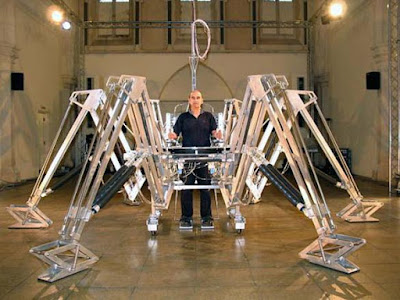The most intriguing element of this week's topics on medical technologies and art was the idea that humans have begun to explore forms of artistic expression in which inorganic objects are introduced into the human body. In the 3rd video from Professor Vesna's lecture, she discusses Eduardo Kac's implantation of a microchip containing pictures of his family into his leg. Also mentioned is Australian-born artist Stelarc, whose artworks focus on extending the capabilities of the human body. This idea of bodily augmentation is the primary point that I want to focus on for this week's post.
This concept of utilizing medical or scientific technologies to transcend current human capability, also known as transhumanism, is a theme that has been explored in art all throughout mainstream culture. One particular instance of this is a video game from 2011 titled Deus Ex: Human Revolution (I highly encourage anyone into video games to try it out if you haven't!).
The game is set in a dystopian future in which technological advances have enabled the spread of artificial organs known as "augmentations". At the forefront of this revolution is medtech-giant Sarif Industries, a corporation pioneering the development of these so-called augmentations. However, these technologies also begin exposing glaring disparities in social class, between those who can and can't afford augmentations, as well as between warring gang factions that embrace/oppose the spread of augmentations.
Another film that I've watched before exploring this theme is the Indie short film "True Skin".
Similarly, True Skin explores the social class divisions that can occur in a society in which medical technologies that enable body modification become commonplace. Another particularly interesting idea that the film explores is the concept that identity and "self" are not defined by our bodies, but rather by our thoughts and memories. When the narrator is caught by authorities at the end of the film, his memories are uploaded to the cloud, and will be transferred to another host body despite the destruction of his original physical self.
I believe that the intersection of art and medical technology is extremely relevant, because it is a unique way of portraying how our society may look years down the road. How it enables society to push the boundaries of what it means to be human is a point of major fascination for me, and I hope to continue exploring new forms of art embracing this idea.
Sources
Machinima. "Deus Ex Human Revolution E3 2010 Trailer [HD]." YouTube. YouTube, 04 June 2010. Web. 30 Apr. 2017.
"STELARC | EXOSKELETON." Stelarc. Stelarc, n.d. Web. 30 Apr. 2017.
<http://stelarc.org/?catID=20227>.
True Skin. Dir. Stephan Zlotescu. Prod. H1`. Vimeo, 10 Oct. 2012. Web. 30 Apr. 2017.
Uconlineprogram. "Medicine pt3." YouTube. YouTube, 22 Apr. 2012. Web. 30 Apr. 2017.
"What Is Transhumanism?" What Is Transhumanism? N.p., n.d. Web. 01 May 2017.
<http://whatistranshumanism.org/>.
 |
| Stelarc along with his 'Exoskeleton', a pneumatic-powered walking machine controlled by the bodily motions of the user. |
This concept of utilizing medical or scientific technologies to transcend current human capability, also known as transhumanism, is a theme that has been explored in art all throughout mainstream culture. One particular instance of this is a video game from 2011 titled Deus Ex: Human Revolution (I highly encourage anyone into video games to try it out if you haven't!).
The game is set in a dystopian future in which technological advances have enabled the spread of artificial organs known as "augmentations". At the forefront of this revolution is medtech-giant Sarif Industries, a corporation pioneering the development of these so-called augmentations. However, these technologies also begin exposing glaring disparities in social class, between those who can and can't afford augmentations, as well as between warring gang factions that embrace/oppose the spread of augmentations.
Another film that I've watched before exploring this theme is the Indie short film "True Skin".
Similarly, True Skin explores the social class divisions that can occur in a society in which medical technologies that enable body modification become commonplace. Another particularly interesting idea that the film explores is the concept that identity and "self" are not defined by our bodies, but rather by our thoughts and memories. When the narrator is caught by authorities at the end of the film, his memories are uploaded to the cloud, and will be transferred to another host body despite the destruction of his original physical self.
I believe that the intersection of art and medical technology is extremely relevant, because it is a unique way of portraying how our society may look years down the road. How it enables society to push the boundaries of what it means to be human is a point of major fascination for me, and I hope to continue exploring new forms of art embracing this idea.
Sources
Machinima. "Deus Ex Human Revolution E3 2010 Trailer [HD]." YouTube. YouTube, 04 June 2010. Web. 30 Apr. 2017.
"STELARC | EXOSKELETON." Stelarc. Stelarc, n.d. Web. 30 Apr. 2017.
<http://stelarc.org/?catID=20227>.
True Skin. Dir. Stephan Zlotescu. Prod. H1`. Vimeo, 10 Oct. 2012. Web. 30 Apr. 2017.
"What Is Transhumanism?" What Is Transhumanism? N.p., n.d. Web. 01 May 2017.
<http://whatistranshumanism.org/>.
It is crazy to think that the direction in which medical advances are rapidly moving is leading us towards the use of artificial organs and appendages. I liked the point you made in reference to the video game that these medical advances created further social disparities based on monetary capacity. While the use of artificial organs could be extremely helpful in saving lives, we must ask ourselves if this will help everybody, or only those who can afford it. The introduction of these new devices could further widen an existing economic and social gap.
ReplyDelete